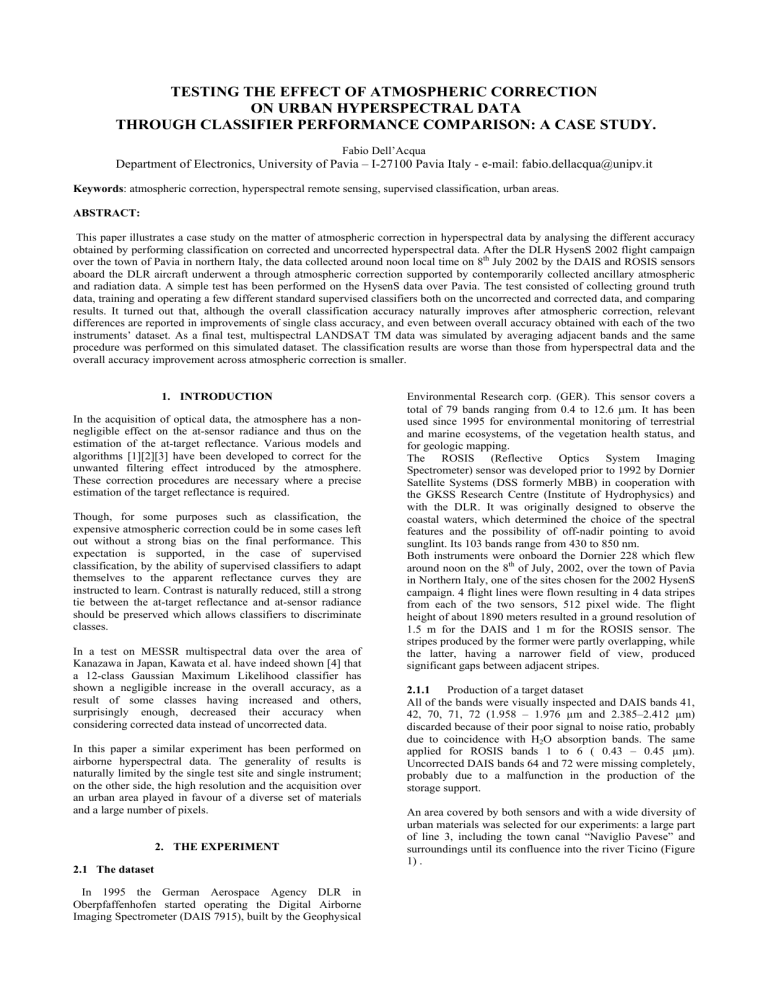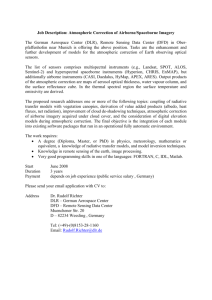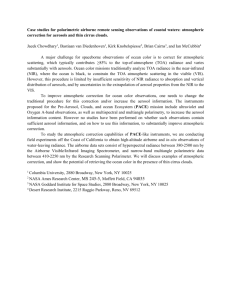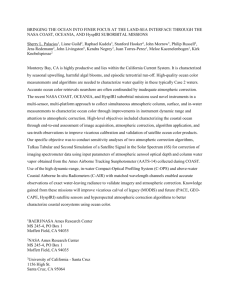TESTING THE EFFECT OF ATMOSPHERIC CORRECTION ON URBAN HYPERSPECTRAL DATA

TESTING THE EFFECT OF ATMOSPHERIC CORRECTION
ON URBAN HYPERSPECTRAL DATA
THROUGH CLASSIFIER PERFORMANCE COMPARISON: A CASE STUDY.
Fabio Dell’Acqua
Department of Electronics, University of Pavia – I-27100 Pavia Italy - e-mail: fabio.dellacqua@unipv.it
Keywords : atmospheric correction, hyperspectral remote sensing, supervised classification, urban areas.
ABSTRACT:
This paper illustrates a case study on the matter of atmospheric correction in hyperspectral data by analysing the different accuracy obtained by performing classification on corrected and uncorrected hyperspectral data. After the DLR HysenS 2002 flight campaign over the town of Pavia in northern Italy, the data collected around noon local time on 8 th July 2002 by the DAIS and ROSIS sensors aboard the DLR aircraft underwent a through atmospheric correction supported by contemporarily collected ancillary atmospheric and radiation data. A simple test has been performed on the HysenS data over Pavia. The test consisted of collecting ground truth data, training and operating a few different standard supervised classifiers both on the uncorrected and corrected data, and comparing results. It turned out that, although the overall classification accuracy naturally improves after atmospheric correction, relevant differences are reported in improvements of single class accuracy, and even between overall accuracy obtained with each of the two instruments’ dataset. As a final test, multispectral LANDSAT TM data was simulated by averaging adjacent bands and the same procedure was performed on this simulated dataset. The classification results are worse than those from hyperspectral data and the overall accuracy improvement across atmospheric correction is smaller.
1.
INTRODUCTION
In the acquisition of optical data, the atmosphere has a non-
Environmental Research corp. (GER). This sensor covers a total of 79 bands ranging from 0.4 to 12.6 µ m. It has been used since 1995 for environmental monitoring of terrestrial negligible effect on the at-sensor radiance and thus on the estimation of the at-target reflectance. Various models and and marine ecosystems, of the vegetation health status, and for geologic mapping. algorithms [1] [2] [3] have been developed to correct for the unwanted filtering effect introduced by the atmosphere.
The ROSIS (Reflective Optics System Imaging
Spectrometer) sensor was developed prior to 1992 by Dornier
These correction procedures are necessary where a precise estimation of the target reflectance is required.
Satellite Systems (DSS formerly MBB) in cooperation with the GKSS Research Centre (Institute of Hydrophysics) and with the DLR. It was originally designed to observe the
Though, for some purposes such as classification, the expensive atmospheric correction could be in some cases left coastal waters, which determined the choice of the spectral features and the possibility of off-nadir pointing to avoid out without a strong bias on the final performance. This expectation is supported, in the case of supervised classification, by the ability of supervised classifiers to adapt themselves to the apparent reflectance curves they are sunglint. Its 103 bands range from 430 to 850 nm.
Both instruments were onboard the Dornier 228 which flew around noon on the 8 th of July, 2002, over the town of Pavia in Northern Italy, one of the sites chosen for the 2002 HysenS instructed to learn. Contrast is naturally reduced, still a strong tie between the at-target reflectance and at-sensor radiance campaign. 4 flight lines were flown resulting in 4 data stripes from each of the two sensors, 512 pixel wide. The flight should be preserved which allows classifiers to discriminate classes. height of about 1890 meters resulted in a ground resolution of
1.5 m for the DAIS and 1 m for the ROSIS sensor. The
In a test on MESSR multispectral data over the area of stripes produced by the former were partly overlapping, while the latter, having a narrower field of view, produced
Kanazawa in Japan, Kawata et al. have indeed shown [4] that a 12-class Gaussian Maximum Likelihood classifier has significant gaps between adjacent stripes. shown a negligible increase in the overall accuracy, as a result of some classes having increased and others, surprisingly enough, decreased their accuracy when considering corrected data instead of uncorrected data.
In this paper a similar experiment has been performed on airborne hyperspectral data. The generality of results is naturally limited by the single test site and single instrument; on the other side, the high resolution and the acquisition over an urban area played in favour of a diverse set of materials and a large number of pixels.
2.
THE EXPERIMENT
2.1
The dataset
2.1.1
Production of a target dataset
All of the bands were visually inspected and DAIS bands 41,
42, 70, 71, 72 (1.958 – 1.976 µm and 2.385–2.412 µm) discarded because of their poor signal to noise ratio, probably due to coincidence with H
2
O absorption bands. The same applied for ROSIS bands 1 to 6 ( 0.43 – 0.45 µm).
Uncorrected DAIS bands 64 and 72 were missing completely, probably due to a malfunction in the production of the storage support.
An area covered by both sensors and with a wide diversity of urban materials was selected for our experiments: a large part of line 3, including the town canal “Naviglio Pavese” and surroundings until its confluence into the river Ticino (Figure
1) .
In 1995 the German Aerospace Agency DLR in
Oberpfaffenhofen started operating the Digital Airborne
Imaging Spectrometer (DAIS 7915), built by the Geophysical
Figure 1: The section of ROSIS image considered, over and around the town canal flowing from left (North) to right (South).
A third data subset was synthesised by averaging DAIS bands to simulate LANDSAT ETM+ instrument bands 1 to 5 and 7
(thermal band 6 was reputed immaterial for land cover classification). ETM+ band 1 was only partly covered due to the DAIS lower wavelength limit.
2.1.2
Production of a ground truth
In order to obtain as a standardised class set as possible, the
CORINE land cover [5] levels I-II were taken as a reference point, crosschecked with the actual availability of material in the target area. Six classes were set: water, streets, “red roof tiles”, industrial buildings, meadows, trees, with an average of about 752 and 5578 pixels each for DAIS and ROSIS respectively. The ground truth was then split into two parts to obtain a training set (lower half of the images) and a test set
(upper part). The two sets were kept definitely separate, as seen in Figure 2, in order to get as an unbiased evaluation of the results as possible.
Figure 2: the test set (left of the white line) and the training
Care was taken to include ground truth from both left and right sides of the image, to account for the different sensor angle with respect to the sun angle.
2.2
set (right of the white line) used in our experiments. For reasons of space, the image was rotated 90° counter-clockwise with respect to its original orientation on which the description in the text is based.
The classification
As the focus here is not on the classifiers themselves but rather on the classification procedure, we chose a simple set of standard classifiers to perform our classification test. DAIS data was classified using the unsupervised K-Means (K-M) as a reference, and the supervised Minimum Distance (MND) and Mahalanobis Distance (MHD). ROSIS was classified using K-Means, Mahalanobis Distance and Maximum
Likelihood (ML). Supervised classification was performed using the full set of usable bands (i.e. except those discarded due to the poor SNR), while for unsupervised classifiers about 1 in 5 bands were used, in order to reduce the computation burden on the classifier and exploit only those bands apparently least correlated with each other.
Results were evaluated using the confusion matrix and Kappa coefficient for supervised classification, while for unsupervised classification the output classes were first sensibly matched with the ground truth classes. The whole procedure was repeated identically on corrected and uncorrected data.
3.
EVALUATION OF THE RESULTS
3.1
Hyperspectral
DAIS data are sensitive to the atmospheric correction, which raises the total accuracy relevantly with both MHD and
MND. In the MHD a definite improvement in class “Water” accuracy is reported (from 5.71 to 33.14%); a significant improvement occurs also in the class “Meadows” (from 67.13 to 72.22%). Also the Kappa coefficient increases slightly, from 0.73 to 0.78. In MND a great improvement of the total accuracy is due to the huge improvement of the class
“Industrial buildings” whose accuracy raised from 14.93% to nearly 100%. Classification of “Meadows” and “Trees” also improves, but the remaining classes (“Water” “streets” and
“red roof tiles”) worsen relevantly. Class “Water”, for example, drops from 56.57% to 10.86%. Instead, the Kappa coefficient improves significantly, from 0.59 to 0.73.
Results with unsupervised classification were largely unsatisfactory both before and after correction, with accuracy around 50% and Kappa coefficients around 0.36.
Accuracy results on ROSIS data does not vary as much after atmospheric correction. In MHD the errors in the different classes does not vary significantly if not for class “Water” whose commission error rate drops from 3.77% to 1.67%.
Also with ML a slight decrease in error rates for class
“Water” are reported (omission error rate drops from 3.41% to 2.39%). In K-M classification the overall accuracy decreases from 47.0426% to 44.7275%. Worst performance are in class “red roof tiles” (72.94% to 9.71%), counterbalanced by a slight improvement in class “streets” and “meadows”. All of the Kappa coefficients practically remain unchanged (0.79 for MHD, 0.93 into 0.92 for ML).
3.2
Simulated multispectral
Simulated multispectral images generally have a lower total accuracy than DAIS data and are far less sensitive to the atmospheric correction. With ML the improvement in the total accuracy is about 0.7%. MHD reports an even worse total accuracy (70.51% vs. 72.38%). Kappa coefficients change only slightly (0.66 into 0.63 for MHD, 0.76 into 0.77 for ML).
4.
CONCLUSIONS
Although the limited size of the data sample prevents a wide extension of the results, some conclusions can be drawn from this case study:
1.
the classification accuracy improves by a very limited amount (even smaller for ROSIS) using atmospherically corrected data instead of uncorrected data;
2.
the improvement is reported on the overall accuracy, while on a single class there is no guarantee of improvement;
3.
hyperspectral data generally grand a better accuracy then (simulated) multispectral data, probably due to the larger amount of information they convey.
Different responses of different classes to the atmospheric correction may be due to the inhomogeneity of the
atmospheric parameters within the scene: e.g. evaporation may have lead to stronger water absorption in areas closest to the river and the canal. This is currently under investigation.
Moreover, the atmospheric parameters were sensed in a single point (the dept. of electronics) far from the study area.
An attempt to improve results may be made enlarging the training sets.
In any case, the different influence of the atmospheric correction on the class accuracies suggests that the usefulness of an expensive correction procedure be evaluated for the specific case, taking into account what land cover classes are of greater interest.
Future development of this work is planned to include an extension of the ground truth size to evaluate the reliability of these preliminary results, an evaluation of the atmospheric water content in different areas, and a split of the ground truth classes to accommodate the different water content.
ACKNOWLEDGEMENTS
The author wishes to thank the German Aerospace Centre
(DLR) for performing the mission and providing the data which made this work possible, the Head of the Remote
Sensing Unit in Pavia, prof. Paolo Gamba, for sharing such data, and Diego Traverso for performing the classifications.
REFERENCES
[1] Thome, K.; Palluconi, F.; Takashima, T.; Masuda, K.,
“Atmospheric correction of ASTER”. Geoscience and
Remote Sensing, IEEE Transactions on ,Volume: 36 ,
Issue: 4 , July 1998. Pages:1199 – 1211
[2] S. Liang, H. Fang, and M. Chen, “Atmospheric correction of Landsat ETM+ land surface imagery—Part
I: Methods,” IEEE Trans. Geosci. Remote Sensing, vol.
39, pp. 2490–2498, Nov. 2001.
[3] Yamazaki, A.; Imanaka, M.; Shikada, M.; Okumura, T.;
Kawata, Y., “An atmospheric correction algorithm for space remote sensing data and its validation”,
Geoscience and Remote Sensing, 1997. IGARSS '97.
'Remote Sensing - A Scientific Vision for Sustainable
Development'., 1997 IEEE International ,Volume: 4 , 3-
8 Aug. 1997 Pages:1899 – 1901 vol.4
[4] Kawata, Y.; Ohtani, A.; Kusaka, T.; Ueno, S., “On The
Classification Accuracy For The Mos--1 Messr Data
Before And After The Atmospheric Correction”,
Geoscience and Remote Sensing Symposium, 1989.
IGARSS'89. 12th Canadian Symposium on Remote
Sensing. 1989 International ,Volume: 3 , 10 -14 th July,
1989. Pages:1853 – 1856.
[5] On line. Available: http://dataservice.eea.eu.int/dataservice/metadetails.asp?
id=188&i=1







